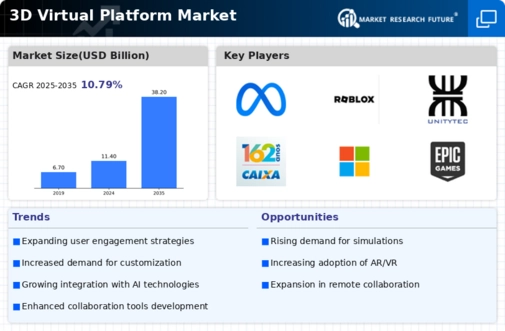Advancements in Technology
Technological advancements play a crucial role in the evolution of the 3D Virtual Platform Market. Innovations in graphics rendering, virtual reality (VR), and augmented reality (AR) are enhancing user experiences and expanding the capabilities of virtual platforms. For instance, the integration of high-definition graphics and real-time rendering technologies has made virtual environments more realistic and engaging. Market data indicates that the VR and AR segments are expected to witness substantial growth, with projections suggesting a market size increase to over 200 billion dollars by 2025. These advancements not only improve user engagement but also attract new sectors to the 3D Virtual Platform Market, including entertainment, real estate, and tourism.
Growing Demand for Remote Collaboration
The 3D Virtual Platform Market is experiencing a notable surge in demand for remote collaboration tools. As organizations increasingly adopt hybrid work models, the need for immersive virtual environments has become paramount. According to recent data, the market for virtual collaboration tools is projected to grow at a compound annual growth rate of 25% over the next five years. This growth is driven by the desire for enhanced communication and teamwork among geographically dispersed teams. The 3D Virtual Platform Market provides solutions that facilitate real-time interaction, allowing users to engage in a shared virtual space. This trend is likely to continue as businesses seek innovative ways to maintain productivity and foster collaboration in a digital-first world.
Rising Interest in Training and Simulation
The 3D Virtual Platform Market is witnessing a growing interest in training and simulation applications across various sectors. Industries such as aviation, healthcare, and manufacturing are increasingly utilizing virtual platforms for training purposes, allowing for safe and cost-effective simulations. Data indicates that the market for simulation-based training is expected to reach 15 billion dollars by 2025, driven by the need for effective skill development and risk management. The immersive nature of 3D virtual environments enhances learning outcomes, making them an attractive option for organizations seeking to improve training efficiency. This trend underscores the potential of the 3D Virtual Platform Market to provide innovative solutions that meet the evolving needs of diverse industries.
Emergence of Virtual Events and Experiences
The rise of virtual events is reshaping the landscape of the 3D Virtual Platform Market. Organizations are increasingly turning to virtual platforms to host conferences, trade shows, and social gatherings, providing attendees with immersive experiences that transcend geographical limitations. Market analysis suggests that the virtual events sector is expected to grow significantly, with estimates indicating a market size of over 100 billion dollars by 2025. This trend reflects a shift in how businesses and individuals engage with one another, as virtual events offer unique opportunities for networking and collaboration. The 3D Virtual Platform Market is thus poised to capitalize on this trend, offering tailored solutions that enhance the virtual event experience.
Increased Investment in Gaming and Entertainment
The gaming and entertainment sectors are significantly contributing to the growth of the 3D Virtual Platform Market. With the rise of immersive gaming experiences, companies are investing heavily in developing advanced virtual platforms. The gaming industry alone is projected to reach a market value of 300 billion dollars by 2025, with a substantial portion allocated to 3D virtual environments. This investment is fostering innovation and attracting a diverse audience, from casual gamers to professional eSports players. The 3D Virtual Platform Market is thus positioned to benefit from this influx of capital, leading to the development of more sophisticated and engaging virtual experiences that cater to a wide range of users.

















Leave a Comment